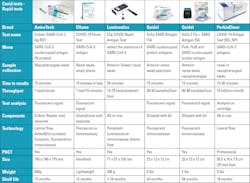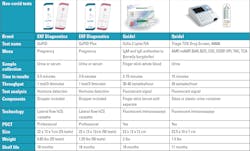History of rapid testing
The first rapid test was developed in 1962 for glucose testing, and in 1976, the FDA approved the first three home pregnancy tests.1
“A rapid test is based on immunochromatographic, lateral flow technology or other similar platform, and has the capability to provide presumptive test results within a short period of time to allow faster medical intervention,” said Charlie Huang, PhD, Head of Diagnostics and Life Science at AnteoTech Ltd.
He clarified, “There are different types of immunochromatographic rapid tests, including antigen rapid tests and antibody rapid tests, or isothermal-PCR based molecular diagnostics, that can detect analytes in a variety of biological matrices, including urine, whole blood, oral fluid and feces. Rapid tests can detect analytes present in the body as a result of disease, infection, substance abuse and status of hormones or biomarkers, etc.”
Antibody testing helps understand the kinetics of the immune response to infection, disease severity and timeline. From determining whether cross-reactivity with other coronaviruses (CoV) leads to cross-protection, to determining immunity and duration, testing influences public health protective measures.
Testing is key to the diagnosis and triage of patients, contact tracing, studying lasting immunity, as well as sero-epidemiological analysis to discover the extent of a spreading disease.
Rapid testing for SARS-CoV-2
POCT immunoassays detect IgG and IgM rapidly to discover if a patient has SARS-CoV-2 antibodies. Home tests have the advantage of obtaining a diagnosis without sending samples to labs. For rural areas and communities without necessary laboratories, this enables widespread testing without a trained professional, reducing training and waiting for lab results.
Cheap to manufacture, store and distribute, digital results may also be sent instantly with some tests for contact tracing.
There are two lines on a membrane strip of lateral flow assays. The gold nanoparticle–antibody conjugates are located on one line and bind antibodies on the other when the blood hits the membrane. Proteins are drawn through the membrane strip by capillary action, as the antigen binds to the gold nanoparticle–antibody conjugate, and the complex flows across the membrane. Low antibody concentrations may result in false-negatives.2
Since antigen tests vary in sensitivity, people who test negative may still be infected. For COVID-19, sensitivities are highest in the first week of illness when viral loads are higher.3
Though antigen tests can replace laboratory-based RT-PCR when immediate decisions about patient care must be made, or where RT-PCR cannot be delivered in a timely manner, positive predictive values suggest that confirmatory testing of those with positive results may be considered in low prevalence settings.3
Advances in rapid testing
The pandemic inspired a plethora of new tests, including smart phones tests, such as the Clip COVID rapid antigen test. “The test is machine-read to reduce human error from misinterpreting faint lines on a lateral flow test, and also reports results automatically to reduce administrative time and errors,” explained Jordan Hirsch, Sales Development Representative, Luminostics.
Huang shared how the EuGeni tests have WiFi, ethernet connectivity, fully integrated laboratory information data management system capability and a barcode scanner. “The use of rapid tests provides a reliable decision support tool, especially in low resource environments and when time to patient care is critical.”
The Ellume COVID-19 Home Test has built-in sampling and reagent controls, connectivity with the smart phone app to transmit results in real-time to health authorities for tracking, and generates an error message to indicate insufficient sample.
Rapid tests are an affordable, easy to use, analytical method that enables point of care testing (POCT), providing quick test results with a noninvasive sample collection on the spot, eliminates sample transportation and storage, saving time and money.
Arvind Kothandaraman, General Manager of Specialty Diagnostics, PerkinElmer, discussed how COVID-19 testing can impact public health. “Rapid tests, such as this one, transformed the COVID-19 testing landscape and will continue to play an important role for screening both asymptomatic and symptomatic individuals in high risk environments like travel hubs, schools, sporting arenas and other large events venues. By offering users a means of simple sample collection and quick turnaround for results, individuals who test positive for SARS-CoV-2 infection can promptly isolate and seek treatment as needed.”
Companies have not been pigeon-holed into only COVID testing. Jody Vacala, Manager of Marketing Communications at Quidel, compared, “As flu season approaches, it is critical for providers to be able to differentiate flu and SARS infection quickly, and with this test, that can all be done with one swab on one test cassette” with the Sofia 2 Flu + SARS FIA. Whereas, the “Triage Tox Drug Screen 94600 rapidly identifies the impact of drug use on the patient’s clinical presentation, which can reduce their length of stay in the emergency department.”
Quidel offers additional testing, such as the Sofia 2 Lyme FIA for detecting Lyme disease, especially important to expectant mothers, as Lyme disease is associated with placenta infection.
Of course, pregnancy tests continue to be popular rapid tests, as it is critical to test for pregnancy before a medical procedure or issuing prescriptions. Even these advanced, such as EKF Diagnostics offering serum testing in addition to urine.
Rapid tests continue to grow with blossoming technologies. On-demand results give patients less time to worry about the unknown, providing fast answers with easy-to-use diagnostics. It will be interesting to see how technology will continue to integrate into diagnostics.References
- Anfossi L, Giovannoli C, Baggiani C. Introductory Chapter: Rapid Test - Advances in Design, Formats, and Detection Strategies. Rapid Test - Advances in Design, Format and Diagnostic Applications. https://www.intechopen.com/books/rapid-test-advances-in-design-format-and-diagnostic-applications/introductory-chapter-rapid-test-advances-in-design-formats-and-detection-strategies. Published September 26, 2018. Accessed June 29, 2021.
- La Marca A, Capuzzo M, Paglia T, Roli L, Trenti T, Nelson SM. Testing for SARS-CoV-2 (COVID-19): a systematic review and clinical guide to molecular and serological in-vitro diagnostic assays. Reprod Biomed Online. 2020;41(3):483-499. doi:10.1016/j.rbmo.2020.06.001.
- Dinnes J, Deeks JJ, Berhane S, et al. Rapid, point-of-care antigen and molecular-based tests for diagnosis of SARS-CoV-2 infection. Cochrane Database Syst Rev. 2021;3(3):CD013705. Published 2021 Mar 24. doi:10.1002/14651858.CD013705.pub2.







